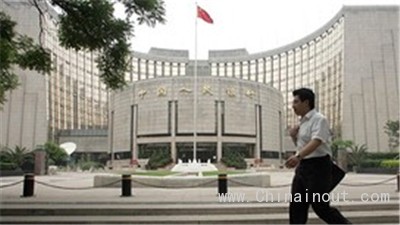中國(guó)已采取措施刺激不斷放緩的經(jīng)濟(jì),,央行大幅下調(diào)商業(yè)銀行存款準(zhǔn)備金率,這個(gè)強(qiáng)大的信號(hào)表明政府有意提振疲弱的增長(zhǎng)。
中國(guó)央行下調(diào)金融機(jī)構(gòu)存款準(zhǔn)備金率1個(gè)百分點(diǎn),,讓商業(yè)銀行有更多資金向企業(yè)放貸,。幾天前發(fā)布的數(shù)據(jù)顯示,中國(guó)經(jīng)濟(jì)在今年第一季度以6年來(lái)最慢的速度擴(kuò)張,。
中國(guó)央行以往只有一次以同樣大的幅度下調(diào)存準(zhǔn)率,,那是在2008年11月,即金融危機(jī)最嚴(yán)重時(shí)期,。
“這個(gè)信號(hào)清楚地表明,,中國(guó)已進(jìn)入一個(gè)激進(jìn)的貨幣寬松周期,以對(duì)抗經(jīng)濟(jì)放緩和不斷上升的通縮風(fēng)險(xiǎn),。”澳新銀行(ANZ)的經(jīng)濟(jì)學(xué)家們表示,,“這個(gè)出人意料之舉似乎表明,當(dāng)局對(duì)中國(guó)企業(yè)面對(duì)的實(shí)際利率居高不下問(wèn)題感到沮喪,。”
存款準(zhǔn)備金率(簡(jiǎn)稱RRR)規(guī)定了商業(yè)銀行吸納的存款中,,有多大一部分必須存在中國(guó)央行,這些資金不能用于放貸和進(jìn)行其他投資,。
此前,,中國(guó)自去年11月以來(lái)已兩次下調(diào)基準(zhǔn)利率,一次下調(diào)存準(zhǔn)率,。最近這次下調(diào)使存準(zhǔn)率降至18.5%,,力度超出分析師之前預(yù)期的本月某個(gè)時(shí)刻降準(zhǔn)50個(gè)基點(diǎn)。幾天前發(fā)布的數(shù)據(jù)顯示,,受建筑業(yè)和制造業(yè)放緩的拖累,,今年首季度中國(guó)經(jīng)濟(jì)同比增速放緩至7%。
這是自2009年初以來(lái)最疲弱的季度擴(kuò)張,。中國(guó)政府此前宣布,,2015年增長(zhǎng)目標(biāo)為“7%左右”。
中國(guó)近年來(lái)的迅猛增長(zhǎng)迫使央行保持較高的存準(zhǔn)率,,以幫助控制資本流入,。但現(xiàn)在,增長(zhǎng)放緩已減少了境外資金流入,,而中國(guó)各銀行的凈外匯購(gòu)買量在去年12月和今年1月錄得史上最大幅度的下降,。
“隨著資本流入直線下滑,央行僅僅是為了保持貨幣政策中性,,就需要以相當(dāng)大的幅度下調(diào)存款準(zhǔn)備金率,,”龍洲經(jīng)訊(Gavekal Dragonomics)的白安儒(Andrew Batson)表示。這家研究公司預(yù)測(cè),,中國(guó)今年將下調(diào)存款準(zhǔn)備金率200個(gè)基點(diǎn)或更多,。
下調(diào)存準(zhǔn)率的消息在周日出爐的前一天,,官方數(shù)據(jù)顯示,3月份新房均價(jià)連續(xù)第七個(gè)月出現(xiàn)同比下降,。
然而,,在多個(gè)城市出臺(tái)鼓勵(lì)購(gòu)房的措施后,房?jī)r(jià)降幅與2月份相比有所收窄,。上海的房?jī)r(jià)持平,,而北京和深圳的房?jī)r(jià)有所上漲。
房?jī)r(jià)下降的放緩似乎表明,,過(guò)去一年出臺(tái)的放松措施正開(kāi)始產(chǎn)生效果。
在中國(guó)國(guó)家統(tǒng)計(jì)局追蹤的全國(guó)70個(gè)大中城市中,,有50個(gè)城市的新建商品住宅價(jià)格在3月份環(huán)比下降,,而前一個(gè)月的這個(gè)數(shù)字為66個(gè)。根據(jù)英國(guó)《金融時(shí)報(bào)》對(duì)中國(guó)官方數(shù)據(jù)的分析,,3月份平均房?jī)r(jià)同比下降6.1%,,但環(huán)比降幅只有0.2%。2月份的房?jī)r(jià)環(huán)比降幅為0.4%,。
從水泥,、建筑到家具和其他消費(fèi)品,房地產(chǎn)支撐著大約40個(gè)行業(yè),。它大約占到中國(guó)經(jīng)濟(jì)活動(dòng)的15%,。
春季購(gòu)房量的正常上揚(yáng)起到了一定作用,但房產(chǎn)中介也報(bào)告稱,,他們比平常更忙了,。
“過(guò)去一個(gè)月的銷售速度高于過(guò)去兩三年。一些在市場(chǎng)上放了一年多的公寓突然就賣掉了,,”北京房產(chǎn)中介萬(wàn)潔(音)表示,。
上月下旬,當(dāng)局降低了購(gòu)買第二套住房的首付款要求,,并將營(yíng)業(yè)稅的免征門檻從五年縮短至兩年,。這些舉措出臺(tái)之際,中國(guó)政府越來(lái)越擔(dān)憂整體經(jīng)濟(jì)放緩的速度,。
這些放松舉措逆轉(zhuǎn)了前總理溫家寶出臺(tái)的限制政策,,后者意在抑制銀行放貸和購(gòu)房行為,以遏止在政治上失分的高端房?jī)r(jià)上漲,。
這些政策幫助推動(dòng)了中國(guó)影子銀行業(yè)的增長(zhǎng)(因?yàn)榉康禺a(chǎn)開(kāi)發(fā)商在絕望之下轉(zhuǎn)向不受監(jiān)管的高息貸款),,并且標(biāo)志著國(guó)有開(kāi)發(fā)商進(jìn)入了一個(gè)此前由民營(yíng)企業(yè)家主導(dǎo)的部門。
中國(guó)進(jìn)出口網(wǎng)
中國(guó)進(jìn)出口網(wǎng)
China has acted to stimulate its slowing economy, cutting sharply the level of cash commercial banks must park with the central bank in a strong signal of intent to boost flagging growth.
The People’s Bank of China moved to free up cash to lend to business by cutting its so-called the reserve requirement ratio by 1 percentage point just days after data revealed the country’s economy expanded its slowest pace for six years in the first quarter.

The PBoC has only once before reduced the reserve requirement ratio by as much and that was during the depths of the financial crisis in November 2008.
“This clearly signals that China has entered into an aggressive monetary easing cycle, to counter the economic slowdown and the rising deflation risk,” said economists at bank ANZ. “This surprising move suggests the authorities are frustrated by the stubbornly high real interest rates facing the Chinese enterprises.”
The required reserve ratio, known as the RRR, specifies the portion of a commercial bank’s deposits that must be held on reserve at China’s central bank, wher it is unavailable for loans and other investments.
China has already cut benchmark interest rates twice and lowered the RRR once since November. The size of the latest reduction to 18.5 per cent exceeds analyst expectations for a 50 basis point cut sometime this month, after first-quarter growth slipped to 7 per cent, held back by a slowdown in construction and manufacturing.
That was the weakest quarterly expansion since early 2009. The Chinese government had previously announced a growth target of “around 7 per cent” for 2015.
China’s booming growth in recent years forced the PBOC to keep bank reserves high to help manage capital inflows. But now, slower growth has reduced the amount of foreign money flowing in while Chinese banks’ net foreign exchange purchases recorded their largest-ever decline in December and January.
“With the fall-off in capital inflows the central bank needs to cut reserve requirements fairly substantially just to keep monetary policy neutral,” said Andrew Batson of Gavekal Dragonomics, which forecasts that China will cut RRR by 200 basis points or more this year.
The move to lower the RRR on Sunday came a day after official data showed average new home prices fell year on year for a seventh consecutive month in March.
However, the dro narrowed from February after a number of cities introduced measures to encourage purchases. In Shanghai, home prices were flat, while prices in Beijing and Shenzhen rose.
The slower pace of decline in property prices suggests loosening measures adopted over the past year are starting to feed through.
New home prices fell in 49 of the 70 cities tracked by the statistics bureau, compared with 66 cities last month. Average prices fell by 6.1 per cent in March compared with a year ago, according to an FT analysis of official figures, but only by 0.2 per cent compared with a month earlier. In February, prices dropped 0.4 per cent from the month before.
Real estate supports about 40 industries, from cement and construction to furniture and other consumer goods. It accounts for about 15 per cent of Chinese economic activity.
A normal uptick in home buying during the spring played a role, but property agents also reported they were busier than usual.
“The rate of sales has been higher in the past month than it has for the past two or three years. Some apartments that have been on the market for over a year have suddenly sold,” said Wan Jie, a real estate agent in Beijing.
Late last month, authorities reduced minimum down payments for buyers of second homes and also cut to two years the length of time a seller had to have owned the home in order to avoid paying a business tax. The moves come as Chinese authorities become increasingly concerned at the rate at which the country’s broader economic growth is slowing.
The relaxing of restrictions winds back constraints put in place by former premier Wen Jiabao, whose curbs on bank lending and property purchases were designed to stop a politically unpopular rise in high-end housing prices.
Those policies helped feed the growth of China’s shadow banking sector, as desperate property developers turned to unregulated high-interest loans, and marked the incursion of state-owned developers into a sector that had previously been dominated by private entrepreneurs.











